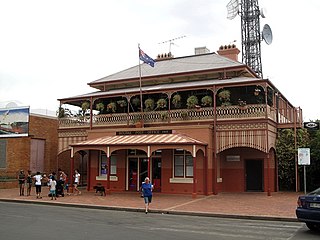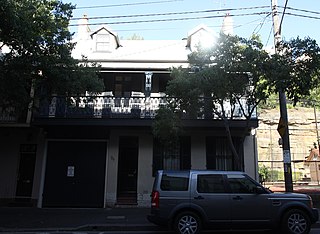
The Queen Victoria Building is a heritage-listed late-nineteenth-century building located at 429–481 George Street in the Sydney central business district, in the state of New South Wales, Australia. Designed by the architect George McRae, the Romanesque Revival building was constructed between 1893 and 1898 and is 30 metres (98 ft) wide by 190 metres (620 ft) long. The domes were built by Ritchie Brothers, a steel and metal company that also built trains, trams and farm equipment. The building fills a city block bounded by George, Market, York, and Druitt Streets. Designed as a marketplace, it was used for a variety of other purposes, underwent remodelling, and suffered decay until its restoration and return to its original use in the late twentieth century. The property is co-owned by the City of Sydney and Link REIT, and was added to the New South Wales State Heritage Register on 5 March 2010.

Emu Plains railway station is a heritage-listed railway station located on the Main Western line in the western Sydney suburb of Emu Plains in the City of Penrith local government area of New South Wales, Australia. It was designed by the New South Wales Government Railways and built from 1884 to 1907 by M. Reed, et al. It is also known as Emu Plains Railway Station group. The property was added to the New South Wales State Heritage Register on 2 April 1999. The station is served by Sydney Trains' T1 Western line services and NSW TrainLink's Blue Mountains line services.

Parliament House,Sydney is a group of heritage-listed buildings which houses the Parliament of the state of New South Wales. The main building is located on the east side of Macquarie Street in Sydney, the capital of New South Wales. The façade consists of a two-storey Georgian building, the oldest public building in the City of Sydney, flanked by two neo-gothic additions containing the parliamentary chambers. These buildings are linked to a 1970s twelve-storey office block at the rear, facing onto the Domain. It is also variously known as the Parliament of New South Wales, Parliamentary Precinct and the Rum Hospital.

The Chief Secretary's Building is a heritage-listed state government administration building of the Victorian Free Classical architectural style located at 121 Macquarie Street, 65 Bridge Street, and at 44–50 Phillip Street in the Sydney central business district of New South Wales, Australia. The ornate five-storey public building was designed by Colonial Architect James Barnet and built in two stages, the first stages being levels one to four completed between 1873 and 1881, with Walter Liberty Vernon completing the second stage between 1894 and 1896 when the mansard at level five and the dome were added.

The former Plaza Theatre in Sydney, New South Wales is a heritage-listed building designed as a 2000-seat cinema by Eric Heath for the Hoyts Group, and opened in 1930. It is no longer used as a cinema.

The Paddington Post Office is a heritage-listed post office located at 246 Oxford Street in Paddington, a suburb of Sydney, Australia. The post office is owned and operated by Australia Post. The building was also a former telephone exchange. It was designed by the New South Wales Colonial Architect's Office under James Barnet and later Walter Liberty Vernon, and was built by William Farley. The building was added to the Commonwealth Heritage List, the New South Wales State Heritage Register on 22 December 2000, and the Register of the National Estate.

Bourke Post Office is a heritage-listed post office at 47 Oxley Street, Bourke, in the Orana region of New South Wales, Australia. It was designed by the Colonial Architect's Office under James Barnet and built in 1880 by E. Heseler. It is also known as Bourke Post and Telegraph Office. The property is owned by the Keane Family Trust. It was added to the New South Wales State Heritage Register on 23 June 2000.

Wingham Post Office is a heritage-listed post office at Wynter Street, Wingham, Mid-Coast Council, New South Wales, Australia. The original building was designed by the Colonial Architect's Office under James Barnet and constructed by William T. Smith of Cundletown. Additions were designed by the CAO under Barnet's successor, Walter Liberty Vernon, and built by S. A. Levick (1904) and H. W. Alcorn. The property is owned by Australia Post. It was added to the New South Wales State Heritage Register on 22 December 2000.
Old Wollongong East Post Office is a heritage-listed former post office, telegraph office and telephone exchange at 91 Crown Street, Wollongong, New South Wales, Australia. It was designed by the NSW Colonial Architect's Office and built from 1890 to 1892 by Messrs Banks and Whitehouse. Prior to 1968, it was also known as Wollongong Post and Telegraph Office or Wollongong Post Office. It was added to the New South Wales State Heritage Register on 24 January 2003.

Pyrmont Post Office is a heritage-listed former post office and now bank branch office located at 148 Harris Street, in the inner city Sydney suburb of Pyrmont in the City of Sydney local government area of New South Wales, Australia. It was designed by the Government Architect’s Office under Walter Liberty Vernon. The property is owned by Australia Post, an agency of the Commonwealth Government of Australia. It was added to the Australian Commonwealth Heritage List on 22 June 2004 and to the New South Wales State Heritage Register on 22 December 2000.

Bidura House, or simply, Bidura, is a heritage-listed former residence, orphanage and office building located at 357 Glebe Point Road in the inner western Sydney suburb of Glebe, New South Wales, Australia. It was designed by Edmund Thomas Blacket and built in 1860. It is also known as Bidura House Group. It was added to the New South Wales State Heritage Register on 28 August 2017.

The Rocks branch of the English, Scottish and Australian Bank is a heritage-listed former bank building and now restaurant located at 131–135 George Street in the inner city Sydney suburb of The Rocks in the City of Sydney local government area of New South Wales, Australia. It was designed by William Wardell and built during 1886. It is also known as the English Scottish & Australian Chartered Bank (former) - Amo Roma Restaurant and Vault Restaurant; the Institute of Marine Power Engineers; Five Bells; and Ox on the Rocks. The property is owned by the Sydney Harbour Foreshore Authority, an agency of the Government of New South Wales. It was added to the New South Wales State Heritage Register on 10 May 2002.

Palisade Hotel is a heritage-listed pub and hotel located at 35–37 Bettington Street, in the inner city Sydney suburb of Millers Point of New South Wales, Australia, adjacent to Barangaroo Reserve. Administratively, the hotel is in the City of Sydney local government area. It was designed by H. D. Walsh and built in 1915–16. It is privately owned. It was added to the New South Wales State Heritage Register on 2 April 1999.

Merchant's House is a heritage-listed education centre and offices at 43–45 George Street in the inner city Sydney suburb of The Rocks in the City of Sydney local government area of New South Wales, Australia. Its design is attributed to John Bibba and was built during 1848. It is also known as Counting House (former) and Merchant's. The building formerly served as a residence, museum, offices and boarding house. The property is owned by Property NSW, an agency of the Government of New South Wales. It was added to the New South Wales State Heritage Register on 10 May 2002.

182.5–188 Cumberland Street, The Rocks are a series of heritage-listed terrace houses located in the inner Sydney suburb of The Rocks in New South Wales, Australia. They were built during 1890 by William John Finneran. The property is owned by Property NSW, an agency of the Government of New South Wales. It was added to the New South Wales State Heritage Register on 10 May 2002.

Toxteth is a heritage-listed residence located at 94 Kent Street, in the inner city Sydney suburb of Millers Point, New South Wales, Australia. It was added to the New South Wales State Heritage Register on 2 April 1999.

Clydebank is a heritage-listed residence at 43 Lower Fort Street, in the inner city Sydney suburb of Millers Point in the City of Sydney local government area of New South Wales, Australia. It was built from 1824 to 1825 by Robert Crawford. It is also known as Bligh House, Holbeck and St Elmo. It has also served as an art gallery and as offices in the past. It was added to the New South Wales State Heritage Register on 2 April 1999.

107–109 Bathurst Street, Sydney is a heritage-listed former bank building and now KFC fast food restaurant located at 107–109 Bathurst Street, Sydney, New South Wales, Australia. The property is privately owned. It was added to the New South Wales State Heritage Register on 2 April 1999.

Wales House is a heritage-listed former newspaper office building, bank building and now hotel located at 64–66 Pitt Street, in the Sydney central business district, in the City of Sydney local government area of New South Wales, Australia. It was designed by Manson & Pickering and built from 1922 to 1929 by Stuart Bros. It is also known as the Bank of NSW Building. The property is owned by Wales House Nominees Pty Ltd. It was added to the New South Wales State Heritage Register on 2 April 1999. Located on the junction of Pitt, Hunter and O'Connell Streets, the building served as offices for John Fairfax and Sons' The Sydney Morning Herald from 1927 to 1955 before being acquired by the Bank of New South Wales, commonly known as "The Wales", hence the building's name. The building has subsequently been converted into an international hotel, as part of the Radisson Blu hotel chain.

The Bulletin Place Warehouses are a series of three heritage-listed former warehouses and now souvenir sales office, commercial offices, health club, storage area, and restaurant located between 6–18 Bulletin Place, in the Sydney central business district in New South Wales, Australia. The warehouses were built from 1880 and have variously been known as the San Francisco Restaurant. The property is privately owned. It was added to the New South Wales State Heritage Register on 2 April 1999.





















